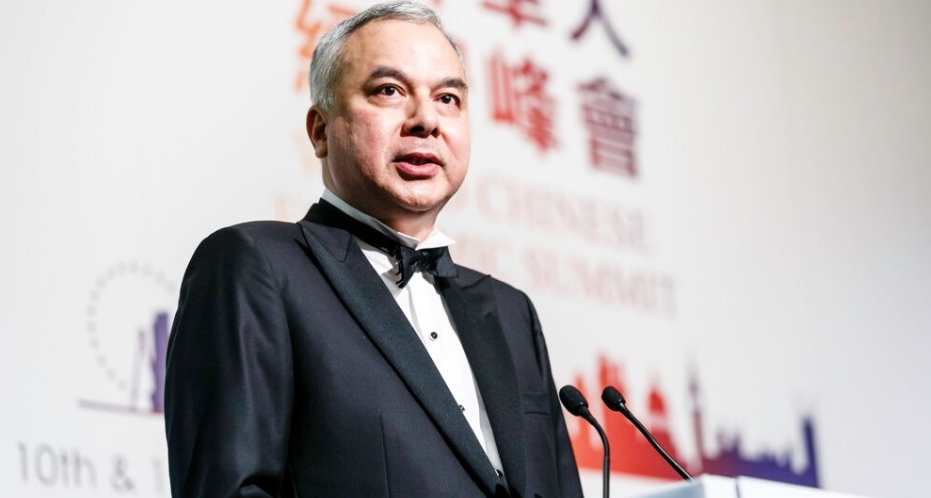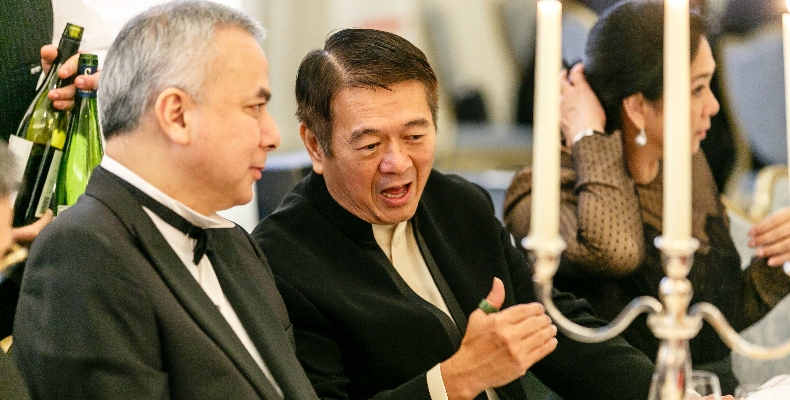Driving commercial and political engagement between Asia, the Middle East and Europe
Driving commercial and political engagement between Asia, the Middle East and Europe
Driving commercial and political engagement between Asia, the Middle East and Europe

The half century of American primacy is giving way to a more diffused economic order where China is set to soon resume its position as the world’s largest economy after a lapse of five centuries, according to a Sultan in Malaysia.
The Sultan of the state of Perak HRH Nazrin Muizzuddin Shah spoke about the significance of China’s proposed New Silk Road in his Royal Keynote Address The New Silk Road: History in the re-making at the 7th World Chinese Economic Summit, co-organised by Asia House and the Asian Strategy and Leadership Institute, which was held in London.
Sultan Nazrin Shah said around 60 countries, including the UK, had signalled their interest and participation in the proposed economic belt, which will stretch from China to Europe, drawn by the “substantial economic and connectivity benefits”.
“We are perhaps on the threshold of another grand design, this time emanating from a country that centuries ago also gave us silk, paper and the chemical explosive that goes into fireworks and gunpowder,” he said.
Speaking at an invitation-only Patron’s Dinner held at The Savoy Hotel during the two-day summit, he also warned that the transcontinental design faced several critical challenges, not least a recent thawing of relations with some ASEAN countries, as well as opposition from two major powers: from the USA , the world’s only superpower and from Japan, the world’s third largest economy – partly in reaction to China’s assertion of what it considers are its rights in the South China Sea and East China Sea.
The proposed initiative spearheaded by Chinese President Xi Jinping is set to create a land route that connects China with the Persian Gulf and the Mediterranean Sea through Central and West Asia as one prong and through Southeast Asia and South Asia as the other.
It also envisages a maritime route which will connect China’s coast with Europe as well as East Africa through the South China Sea and Indian Ocean in one direction and a link with the South Pacific in the other direction.
The stated aim is to revive ancient Silk Road trading routes on land and sea which will expand trade ties and open up new business and investment opportunities. The New Silk Road also plays a role in China’s quest for regional leadership and ambitions to build up regional institutions.
China has already led the setting up of international financial institutions such as the Asian Infrastructure Investment Bank (AIIB), the BRICS New Development Bank and the Silk Road Fund as alternatives to the Bretton Woods institutions “frustrated by the slow pace of reforms in the latter,” the Perak ruler said.
Sultan Nazrin said the Belt and Road plan was vital to the success of China’s stated goals to be a moderately well-off country by 2021 (the 100th anniversary of the Communist Party of China) and to be a modern socialist country by 2049 (the centenary anniversary of the founding of the People’s Republic of China.)
China’s resolve to make the overland and maritime New Silk Road a reality was manifestly clear, he said, pointing out huge efforts had already been made politically, diplomatically and financially to get it off the ground.
The ruler pointed out that President Xi and Chinese Premier Li Keqiang had led more than 20 delegations to Central Asia, South Asia, Europe and Africa to dispel doubts about and promote the initiative.

The Sultan of the state of Perak HRH Nazrin Muizzuddin Shah, left, sat next to Tan Sri Lee Kim Yew, Co-Founder and Patron of the World Chinese Economic Summit (WCES), right, at the Patron’s Dinner held during the WCES at The Savoy Hotel in London. Photo by Miles Willis
They had promoted it at major conferences such as the Boao Forum for Asia. In addition finances were already in place as the Silk Road Fund had now been set up and the AIIB and BRICS New Development Bank “had been mobilised” to finance the project, he said.
The Asian Development Bank (ADB) has estimated that Asia needs infrastructure investment to the tune of US$8 trillion this decade.
If the resolve to create it is sustained, the New Silk Road is set to to become by mid-century a colossal infrastructure of roads, railways, pipelines and maritime routes that straddle two continents, Asia and Europe and lances into another, Africa, he said.
It would kindle growth in remote areas, unlock latent wealth and stimulate transcontinental trade and cultural exchange “to a level not known before.”
There is no question that China could benefit greatly from the initiative, Sultan Nazrin said. China has the world’s largest foreign exchange reserves totalling US$3.5 trillion in September and also has excess manufacturing capacity, estimated by the International Monetary Fund (IMF) to be at 60 per cent in 2012.
“China’s western provinces could do with more infrastructure development and connectivity with Central Asian economies to boost employment, trade and growth,” the monacrh said.
Click below to see a slideshow of photos from the two-day summit:-
But he said the “grand design” – like many before it – was fraught with many challenges and uncertainties.
Complications include “China’s more assertive stance on the territorial disputes it has with its neighbours on sea, and to a lesser extent on land as well,” he said.
China’s growing economic weight fuelled by two decades of double digit average annual GDP growth was translating into stronger political and strategic influence and greater military capacity, which he said had raised concerns in the USA, Japan and India.
The monarch said increased friction between a resurgent China and other major powers, especially the USA, was occurring on various fronts.
The first was on the diplomatic front whereby a newly assertive China was strengthening bilateral ties and partnerships with countries which Japan and the USA felt should remain in their sphere of influence. China’s influence in Africa and in the Pacific Islands are some such examples.
Another challenge to the New Silk Road lies on the security front. Sultan Nazrin said that China’s reclamation and island building measures in the South China and East China Sea had served as setbacks to its security aims and interests, as rather than diminishing the presence of the USA and Japan, these manoeuvres had expanded and entrenched their presence further.
“Accidental incidents in the South China Sea, especially between China and the USA, could lead to unpredictable and unintended results,” he said.
The Sultan said USA defence cooperation with several countries, most notably the Philippines and Japan, had also increased as a result.
“At the same time Beijing has alienated some ASEAN members and lost goodwill and trust among some of them,” he said. “This has impacted negatively upon the smooth execution of the New Silk Road programme not only in maritime Southeast Asia but in the Indian Ocean as well,” he said.
“ASEAN continues to maintain close relations with China fully aware of the powerful strategic reasons for doing so, but its hitherto mild tone on the disputes in the South China Sea and China’s actions in the area has hardened. Vietnam and the Philippines have been the most vocal. Manila has restored defence ties with the United States in a new Enhanced Defence Cooperation Agreement. It has also taken the unprecedented step of filing a case against the Chinese position in the South China Sea with the United Nation’s Permanent Court of Arbitration,” he said.
“Beijing’s actions have enabled the United States to pivot even more firmly into the region. Its perceived role as security provider has received a boost in the region generally and in Japan, the Philippines and Vietnam especially as nations hedge against a China that is seen as acting as a bully.”
He said Japan had reacted by making radical changes to its post-war defence policy and adopting a “more antagonistic stance towards China.”
India too has become concerned about China’s activities around it, he said. He gave as examples the China-Pakistan Economic Corridor that runs through Azad Kashmir, a territory disputed with India and China’s New Silk Road projects in Sri Lanka and the Maldives, as well as a Chinese infrastructure project that could compromise the status of the north-eastern state of Arunchal Pradesh, which is claimed by China.
He said the grand design faced other threats too. There was Taiwan and the situation in some Central Asian states to consider. Pakistan continued to suffer serious political and security problems, the USA and Japan did not support the initiative and were attempting to discourage others from joining it, and Russia felt threatened by the China-led New Silk Road initiative owing to the increased China’s influence on Central Asia, which it regards as its sphere of influence.
Political stability, security and sustained economic growth were critical for its success. However the Belt was vulnerable to terrorist attacks and criminal elements at various points and given that it would take about 40 years to complete, it would have to survive political leadership successions, including in China.
But the Sultan concluded that despite some of the inherent challenges and problems, he was convinced it was in the best interests of Southeast Asia and Europe to not only welcome the initiative but to participate in it.
He said it was up to individual countries to ensure they were not at risk of being swamped by large state-owned enterprises from China.
He pointed out that the economic belt could offer great opportunities to parts of Europe that need investment in infrastructure such as Eastern Europe and pointed out that Europe was China’s largest trading partner.
In the case of Southeast Asia, the New Silk Road initiative could help remedy its substantial infrastructure deficit and facilitate the building of a robust ASEAN Economic Community, he said. He gave several specific examples of how this was already happening, such as Beijing’s pledge to contribute to the Master Plan on ASEAN connectivity that was adopted in 2010. China has pledged US$20 billion in loans for regional infrastructure development and US$3 billion for the China-ASEAN Cooperation Fund.
He said he would not be surprised if ASEAN pursued the conclusion of a Code of Conduct in the South China Sea.
But he added: “I am inclined to think that ASEAN will not allow the differences over the management of disputes in the South China Sea to get in the way of collaboration on New Silk Road projects.”
He said China had repeatedly stressed the New Silk Road projects would be for mutual benefits and that they coordinated with national and regional development plans.
A promising aspect of the project was that China was promoting it as a wealth-creating economic development initiative and not as a wasteful military design, he said.
He concluded: “If China is able to manage its territorial disputes with neighbours more astutely and less robustly, pursues mutual accommodation with other rising powers like India for common purpose and continues to privilege the economic instrument over the military in its foreign policy, I am confident we will see a new dawn for Asia in which the rest of the world can participate and share.
naomi.canton@asiahouse.co.uk
To read the other stories on the World Chinese Economic Summit, which took place in London for the first time this year and was co-organised by Asia House, click here.
Don’t miss this article in which the Deputy Prime Minister of Malaysia Dr Hamidi spoke about the importance of China-ASEAN relations.
